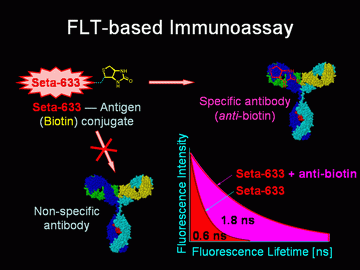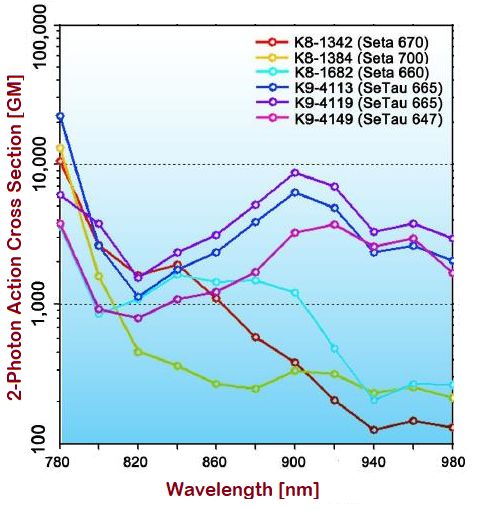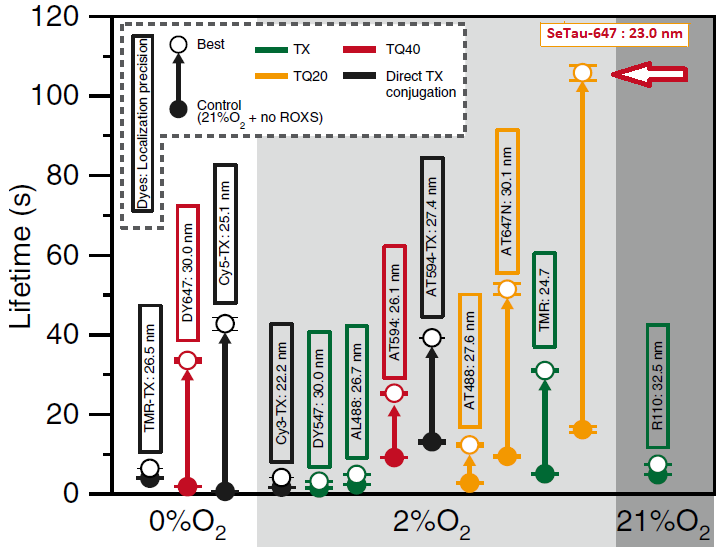Links to Selected Products
- Squaraine Rotaxanes
- Labels
- Probes
- Proteins & Conjugates
- Dyes for Imaging
- Dyes for Click Chemistry
- Dyes for Single Molecule Applications
- Dyes for Immunofluorescence
- Dyes for Proteomics
- Dyes for Flow Cytometry
- Dyes for Fluorescence Polarization Assays
- Dyes for 2-Photon Microscopy
- Dyes for FRET Based Assays
- More Products
- More Applications
Applications
- Fluorescence Imaging
- Flow Cytometry
- DNA and Protein Microarrays
- 2-Photon Microscopy
- Superresolution Microscopy
- Single Molecule Applications
- Immunofluorescence
- Click Chemistry
- Fluorescence Lifetime (FLT)
- Fluorescence Polarization
- FRET
- Genomics
- FCS
- pH Sensing Applications
- Plasmonics
- Proteomics
- Albumin Determination
- Cholesterol & Triglycerides Measurement
- Viscosity Measurements
-
Urbana, IL, Sept 2023SETA BioMedicals is currently collaborating with the Micron School of Materials Science & Engineering at Boise State University on phase 3 of a DOE funded project to develop new fluorescent dyes for DNA-controlled dye aggregation as a path to create quantum entanglement.
-
Urbana, IL, Sept 2021SETA BioMedicals and the Micron School of Materials Science & Engineering at Boise State University are currently collaborating on a DOE funded project.
-
Urbana, IL, June 2019SETA BioMedicals will exhibit at the MAF meeting in La Jolla, CA, USA on Aug 20 - 24, 2019! Please visit us at booth 9 to get information about our latest products.
- More>>
-
SETA BioMedicals offers free consultation on the use of SETA products for your application.
Please call us at 217 417 2160.
Welcome to SETA BioMedicals
SETA BioMedicals is the exclusive producer of Squaraine rotaxanes, the world's brightest, chemically-robust and photostable dyes for biomedical applications.
SETA BioMedicals also produces, commercializes, and licenses other proprietary fluorescent detection reagents (fluorescent dyes, probes, labels, tandems, and standards) for biomedical research applications.
These detection reagents can be ordered over the phone at (217) 417 2160, via e-mail at orders@setabiomedicals.com, or with our online shopping cart and are delivered the next day in the continental USA and within days at any other destination around the world.
-
Squaraine Rotaxanes - Simply the Best!
Conventional fluorescent dyes, particularly those in the red and near-IR spectral region, exhibit lower chemical and photochemical stability, brightness, and fluorescence lifetimes.
Our proprietary squaraine rotaxane dyes are based on a squaraine dye fluorophore, where the central squaraine moiety is protected by a macrocyclic ring, which helps to improve the properties of the final dye (see image above).
This innovative technology has enabled the development of extremely bright, exceptionally photostable, and chemically stable dyes, probes, labels, tandem conjugates, and fluorescent standards for the long-wavelength region. In addition, squaraine rotaxanes exhibit longer fluorescence lifetimes (FLTs) compared to other dyes in the same spectral region.
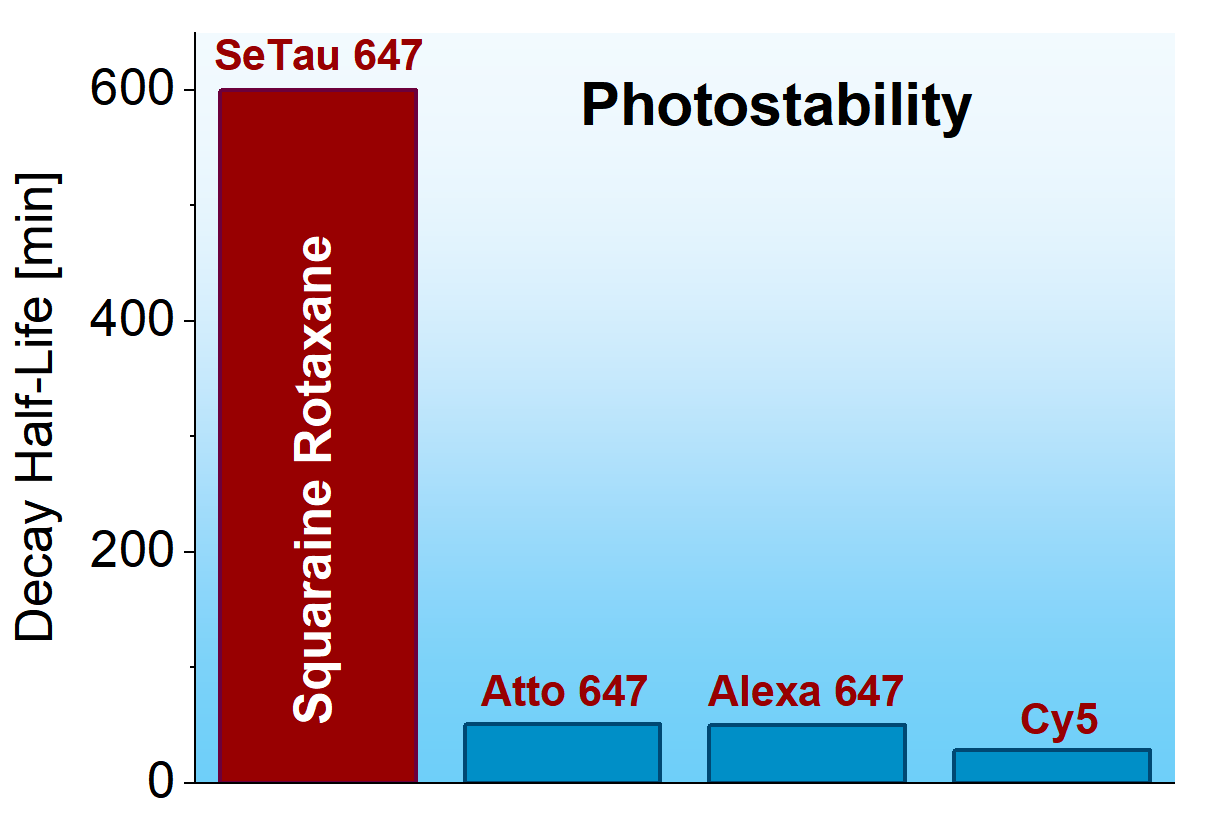
Exceptional photostability of squaraine rotaxanes compared to conventional dyes
Squaraine rotaxanes are available as imaging probes and in reactive forms with NHS-ester, maleimide, azide, and DBCO modifications for a wide range of applications.
-
Click Chemistry Reagents
Azides and proprietary DBCO derivatives of long-lifetime and 2P-imaging dyes with 2PACS of several thousand GM for Cu-catalyzed and Cu-free click chemistry reactions
-
Phycobiliprotein Tandem Conjugates
Bright and photostable tandem-conjugates of APC, PE, and PerCP with Seta dyes for flow cytometry and immuno-fluorescence applications.
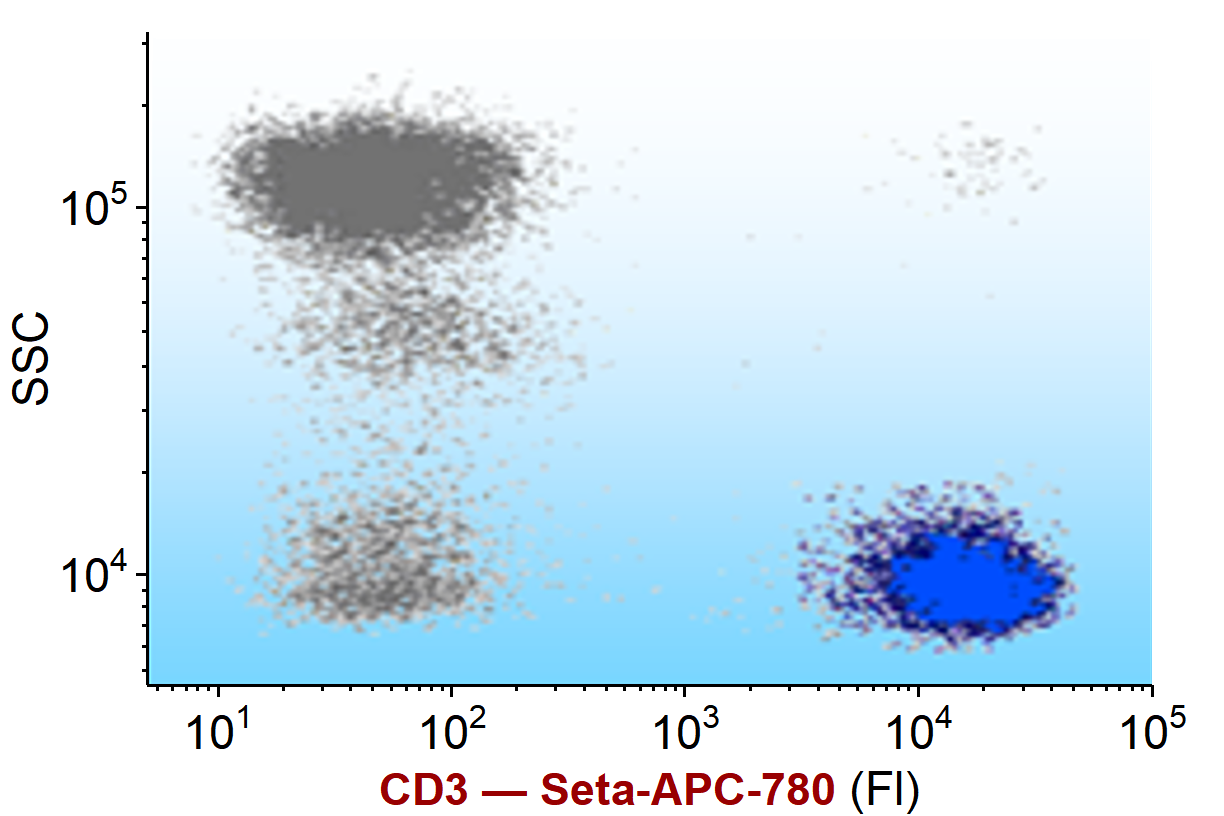
Blood cells stained with CD3-Seta-APC-780 -
Labeling Technologies
Next generation labels for proteins, oligonucleotides and other biomolecules with exceptional brightness and photostability.
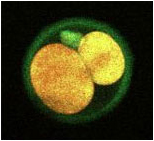
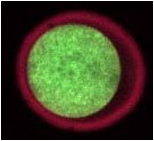
Mouse egg cell stained with
Square-655 and Square-460Mouse egg cell stained with
Square-670-Carboxy -
Fluorescence Lifetime Labels
Fluorescent labels with lifetimes in aqueous buffer systems from 0.5 to 32 ns for fluorescence lifetime- and polarization-based applications.
-
Lifetime and Intensity-Based Calibration Standards
Fluorescence standards that are utilized in the calibration and validation of fluorescence instruments and luminescence readers as fluorescence reference materials. The standard kits offered by SETA BioMedicals are ready and easy to use!
-
Viscosity-Sensitive Probes and Labels
Large Stokes' shift fluorescent molecular rotors with high sensitivity and a large dynamic range in lifetime and intensity mode. They are available in reactive (NHS-ester and maleimide) and non-reactive formats.
-
Exeptional Dyes for 2-Photon Microscopy
Fluorescent probes and labels with exceptionally high 2-photon action cross sections (2PACS) close to 10,000 GM based on squaraines and squaraine rotaxanes.
2-PACS comparison of red-emitting Seta and SeTau dyes
-
Applications of Squaraine Rotaxanes
Exceptionally photostable, chemically stable dyes, and extremely bright probes, labels, tandem conjugates, and fluorescent standards have been developed by SETA BioMedicals based on squaraine rotaxanes.

Due to their extreme resistance to oxidizers, squaraine rotaxanes are advantageous for use in a wide range of biomedical, pharmaceutical, and environmental sensing applications, including:
• Oxidative stress detection assays
• Oxidative damage assays
• Live-cell imaging under oxidative conditions
• Super-resolution microscopy (STORM/STED)
• Immunofluorescence in oxidizing environments
• Photo-oxidation, photodynamic therapy (PDT), and sonodynamic therapy (SDT) studies
• Monitoring of drug delivery and oxidation-triggered drug release
• Detection of oxidative pollutants in water, air, and soil.
-
DNA and Protein Microarrays
Our highly fluorescent squaraine rotaxanes exhibit excellent chemical stability in particular against oxidative reagents e.g. peroxides or ozone and therefore are outstanding detection reagents for use in DNA and protein microarrays. Importantly our customers found that the fluorescence signals of cyanine dyes such as Cy5, Atto and Alexa dyes are strongly dependent on the concentration of ozone during array washing - see our Microarray Signal Stability Comparison and below.
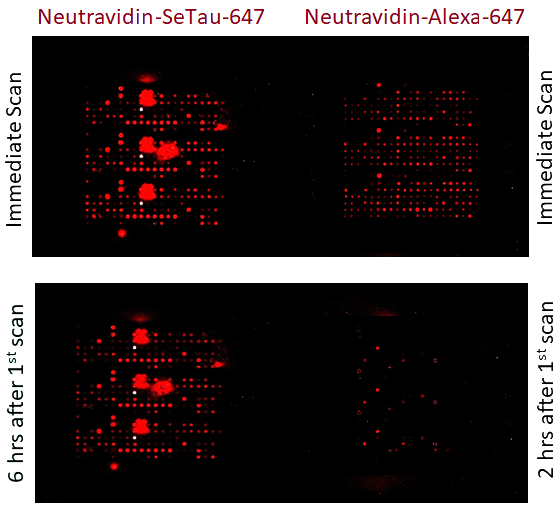
Images of the protein microarray scans of a SeTau-647 rotaxane dye-labeled-neutravidin attached to an immobilized, biotinylated antibody at time = 0 and after 6 hours (left) and an Alexa-647-labeled neutravidin at time = 0 and after 2 hours (right).
-
Microarray Imaging
Below is a comparison of our Seta-555 and SeTau-647 dyes with other dyes commonly used in such microarrays. These dyes are ideal for both, one- and two-color microarray measurements and they have much higher ozone stability as compared to other dyes. Try and experience the difference yourself!
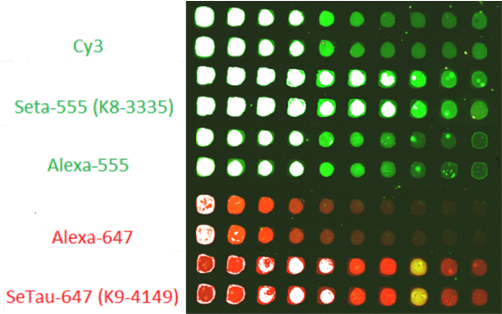
-
Single Molecule Applications
In a comparative study of 13 dyes in Nature Chem. Biol., SeTau-647 (K9-4149 and K9-4148), a squaraine rotaxane dye, exhibited the best photobleaching performance in a single molecule application with an exponential lifetime of 105.8 ns (twice as long as the 2nd best dye Atto-647N).
Single molecule study of 13 fluorescent imaging dyes
-
Superresolution Microscopy
Seta and SeTau dyes are a class of extremely bright and photostable dyes for fluorescence imaging and are well suited for STED and STORM applications.
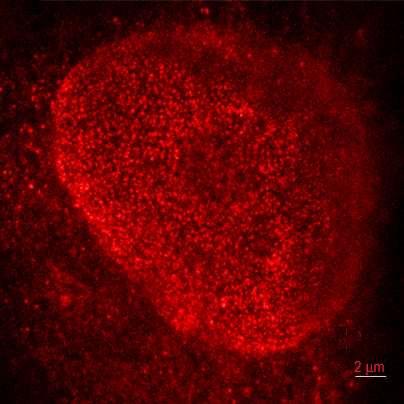
STED image of HeLa-M cell nuclei labeled with primary mAB414 antibody and a secondary antibody labeled with SeTau-647.
-
2-Photon Microscopy
Squaraine and squaraine-rotaxanes have 10 – 50-times higher 2-photon cross-sections compared to conventional cyanine dyes in the order of several thousand GM.
.jpg)
2-Photon image of a neuron filled with a squaraine rotaxane-labeled peptide








_709x200_cc5.jpg)



